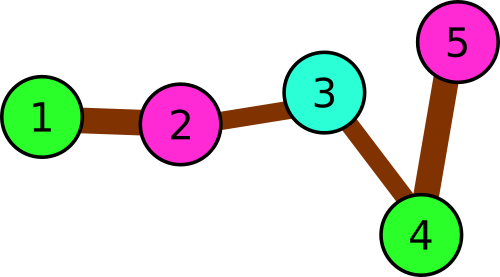Codeforces Round #403 (Div. 2) C. Andryusha and Colored Balloons dfs(树)
来源:互联网 发布:宛然如生,不亦善乎翻译 编辑:程序博客网 时间:2024/06/14 10:08
Andryusha goes through a park each day. The squares and paths between them look boring to Andryusha, so he decided to decorate them.
The park consists of n squares connected with (n - 1) bidirectional paths in such a way that any square is reachable from any other using these paths. Andryusha decided to hang a colored balloon at each of the squares. The baloons' colors are described by positive integers, starting from 1. In order to make the park varicolored, Andryusha wants to choose the colors in a special way. More precisely, he wants to use such colors that if a, b and c are distinct squares that a and b have a direct path between them, and b and c have a direct path between them, then balloon colors on these three squares are distinct.
Andryusha wants to use as little different colors as possible. Help him to choose the colors!
The first line contains single integer n (3 ≤ n ≤ 2·105) — the number of squares in the park.
Each of the next (n - 1) lines contains two integers x and y (1 ≤ x, y ≤ n) — the indices of two squares directly connected by a path.
It is guaranteed that any square is reachable from any other using the paths.
In the first line print single integer k — the minimum number of colors Andryusha has to use.
In the second line print n integers, the i-th of them should be equal to the balloon color on the i-th square. Each of these numbers should be within range from 1 to k.
32 31 3
31 3 2
52 35 34 31 3
51 3 2 5 4
52 13 24 35 4
31 2 3 1 2
In the first sample the park consists of three squares: 1 → 3 → 2. Thus, the balloon colors have to be distinct.
 Illustration for the first sample.
Illustration for the first sample.In the second example there are following triples of consequently connected squares:
- 1 → 3 → 2
- 1 → 3 → 4
- 1 → 3 → 5
- 2 → 3 → 4
- 2 → 3 → 5
- 4 → 3 → 5
 Illustration for the second sample.
Illustration for the second sample.In the third example there are following triples:
- 1 → 2 → 3
- 2 → 3 → 4
- 3 → 4 → 5
 Illustration for the third sample.
Illustration for the third sample.dfs遍历树,形参记录前一个节点和当前节点
对每个点,搜索他连接的且没走的点,因为是树,所以时间很低
对于染色,只要保证每个点和他的父亲,父亲的父亲以及兄弟不同色即可,并且对于一棵树,树上的任何一点都可以做根节点,所以从哪个点开始搜都可以
对于有多少种颜色,可以求完染色数组,统计标记一下求得,也可以记录每个点的度,找到最大再加一,因为只要保证对于每个点所有连的边以及他本身这个点所有颜色都各不相同即可,也就是最大度数加上自己
#include<stdio.h>#include<string.h>#include<math.h>#include<string>#include<algorithm>#include<queue>#include<vector>#include<map>#include<set>#define eps 1e-9#define PI 3.141592653589793#define bs 1000000007#define bsize 256#define MEM(a) memset(a,0,sizeof(a))typedef long long ll;using namespace std;vector<int>w[200005];//存图int ans[200005];//染色数组void dfs(int zi,int node){int i,j=1;for(i=0;i<w[node].size();i++)if(!ans[w[node][i]]){while(j==ans[zi]||j==ans[node])j++;ans[w[node][i]]=j++;//j++作为下一个兄弟的染色初值dfs(node,w[node][i]);}return;}int main(){int n,x,y,i;int book[200005];MEM(book);scanf("%d",&n);for(i=0;i<n-1;i++){scanf("%d %d",&x,&y);w[x].push_back(y);w[y].push_back(x);book[x]++;book[y]++;}int maxx=0;for(i=1;i<=n;i++)maxx=max(maxx,book[i]);ans[1]=1;dfs(0,1);printf("%d\n",maxx+1);for(i=1;i<=n;i++)printf("%d ",ans[i]);return 0; }- Codeforces Round #403 (Div. 2) C. Andryusha and Colored Balloons dfs(树)
- Codeforces Round #403 (Div. 2)C Andryusha and Colored Balloons (dfs)
- Codeforces Round #403 (Div. 2) C. Andryusha and Colored Balloons(DFS 邻接表 数据结构)
- Codeforces Round #403 C. Andryusha and Colored Balloons(DFS)
- Codeforces Round #403 (Div. 2) C. Andryusha and Colored Balloons
- Codeforces Round #403 (Div. 2) C. Andryusha and Colored Balloons
- Codeforces Round #403 (Div. 2) C. Andryusha and Colored Balloons DFS
- codeforces 780-C. Andryusha and Colored Balloons(dfs)
- Codeforces Round #403 div2 C. Andryusha and Colored Balloons
- Codeforces Round #403 C. Andryusha and Colored Balloons
- Codeforces 782C Andryusha and Colored Balloons dfs
- Codeforces 780C Andryusha and Colored Balloons 搜索dfs
- CodeForces 780C Andryusha and Colored Balloons【DFS】
- Codeforces 780C-Andryusha and Colored Balloons dfs
- 【Codeforces Round #403】Codeforces 781A Andryusha and Colored Balloons
- Codeforces Round #403 (Div. 1, based on Technocup 2017 Finals) A. Andryusha and Colored Balloons
- 【codeforces 782C】Andryusha and Colored Balloons
- codeforces 782c Andryusha and Colored Balloons
- UI设计 Android开发尺寸标注
- 博客链接集会
- DBGrid 使用大全
- 堆排序
- 特征离散、归一、交叉解释或实现
- Codeforces Round #403 (Div. 2) C. Andryusha and Colored Balloons dfs(树)
- CentOS6.8系统网卡绑定
- Sketch的使用
- PHP安全
- Java移位运算符
- c++中的浅拷贝和深拷贝问题
- linux ----- head
- 转Linux查找文件(find命令)
- swift函数


